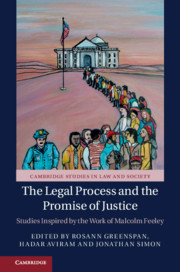Book contents
- The Legal Process and the Promise of Justice
- Cambridge Studies in Law and Society
- The Legal Process and the Promise of Justice
- Copyright page
- Contents
- About the Contributors
- Introduction: Past as Prologue
- Part I The Process Is the Punishment
- Part II Court Reform on Trial
- 5 Regulating E-Cigarettes: Why Policies Diverge
- 6 Japanese Court Reform on Trial
- 7 Court Reform and Comparative Criminal Justice
- 8 The Birth of the Penal Organization: Why Prisons Were Born to Fail
- 9 The Misbegotten: Infanticide in Victorian England
- Part III Judicial Policymaking and the Modern State
- Part IV Political Liberalism and the Legal Complex
- Index
- Books in the Series
- References
8 - The Birth of the Penal Organization: Why Prisons Were Born to Fail
from Part II - Court Reform on Trial
Published online by Cambridge University Press: 18 April 2019
- The Legal Process and the Promise of Justice
- Cambridge Studies in Law and Society
- The Legal Process and the Promise of Justice
- Copyright page
- Contents
- About the Contributors
- Introduction: Past as Prologue
- Part I The Process Is the Punishment
- Part II Court Reform on Trial
- 5 Regulating E-Cigarettes: Why Policies Diverge
- 6 Japanese Court Reform on Trial
- 7 Court Reform and Comparative Criminal Justice
- 8 The Birth of the Penal Organization: Why Prisons Were Born to Fail
- 9 The Misbegotten: Infanticide in Victorian England
- Part III Judicial Policymaking and the Modern State
- Part IV Political Liberalism and the Legal Complex
- Index
- Books in the Series
- References
Summary
A recurring question for students of punishment has been: why, despite more than “one and a half centuries of failure” (Cohen 1979: 341), has the prison persisted? Throughout history, reformers, politicians, voters, and others have assigned prisons myriad tasks associated with crime reduction – various incarnations of rehabilitation, deterrence, and incapacitation. After every significant reform effort, prisons have disappointed. In the 1970s, prisons were accused of failing to rehabilitate (Martinson 1974; Allen 1981), or potentially making prisoners worse through the process of labeling (Becker 1963).
- Type
- Chapter
- Information
- The Legal Process and the Promise of JusticeStudies Inspired by the Work of Malcolm Feeley, pp. 152 - 171Publisher: Cambridge University PressPrint publication year: 2019
References
- 2
- Cited by



